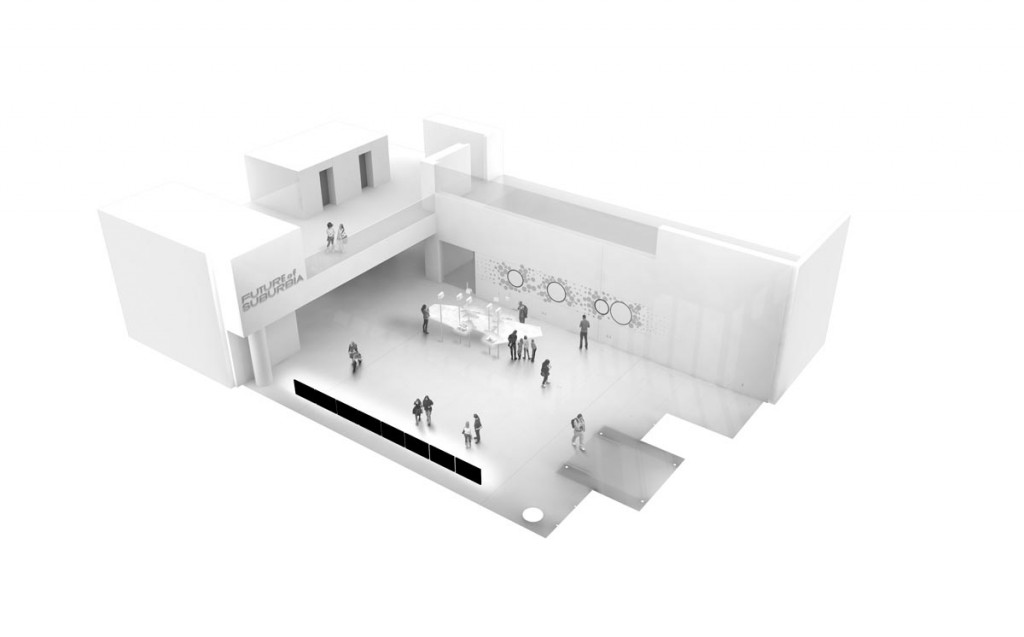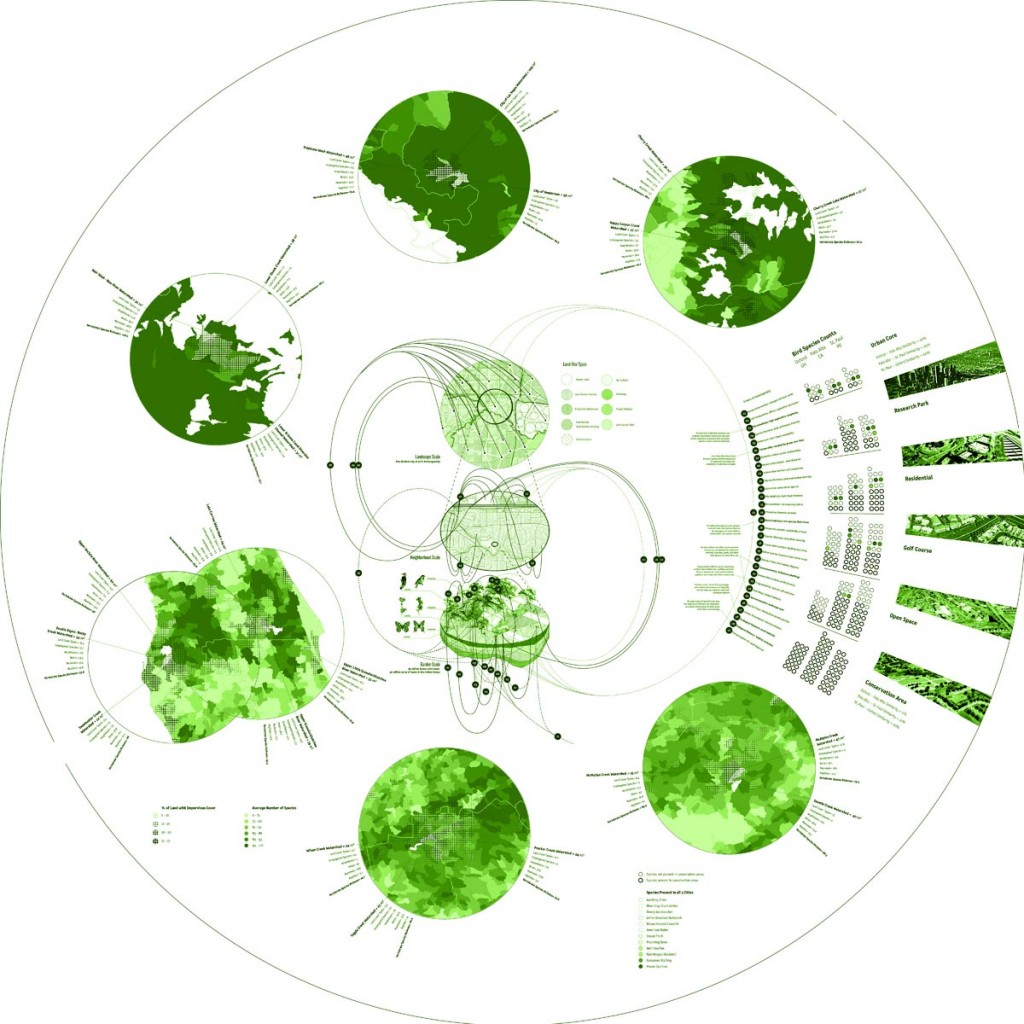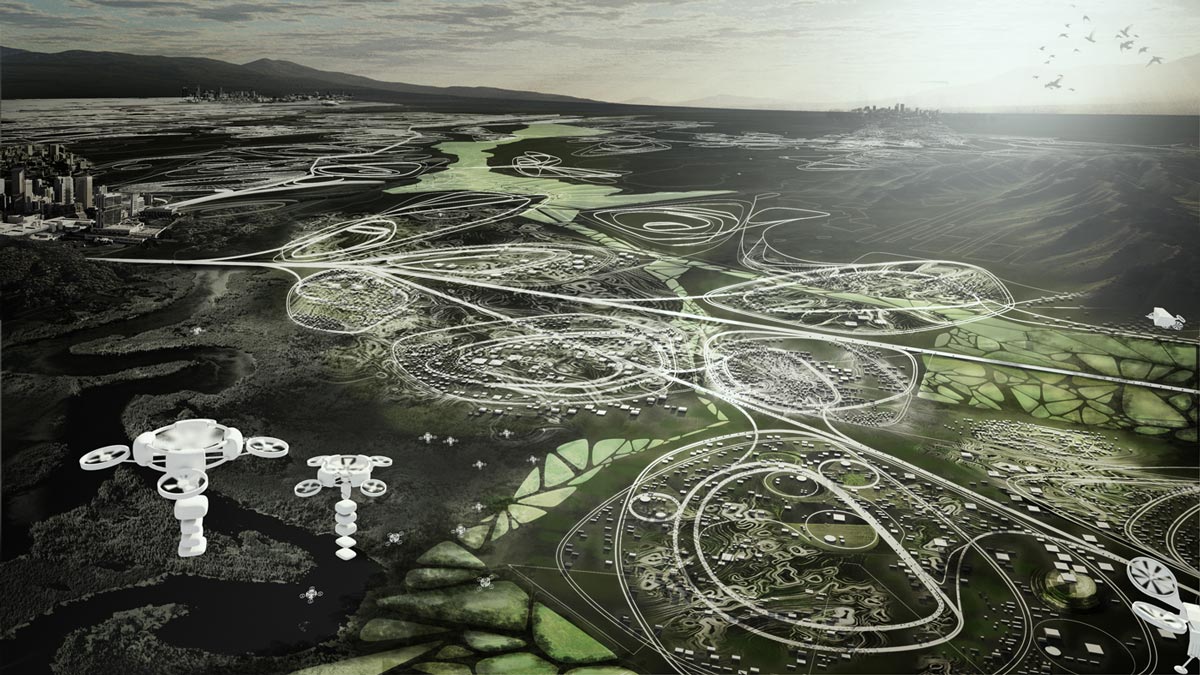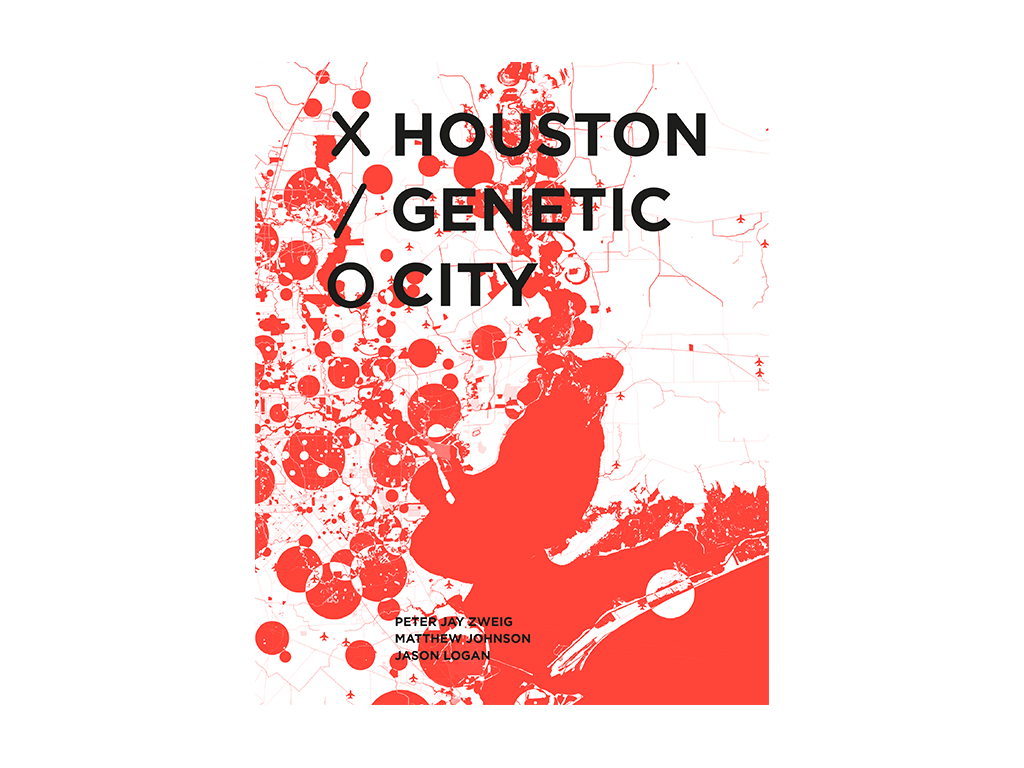Alan M. Berger and Matthew Spremulli in conversation with Roi Salgueiro on “The Future of Suburbia” exhibition.
Roi Salgueiro The Future of Suburbia exhibition was inaugurated last Jan 25. It is a significant part of MIT’s Center for Advanced Urbanism homonymous biennial theme. I would like to know how exploring suburbia participates in the CAU’s overall agenda and also what in particular brought you to this topic.
Alan Berger The CAU was created at MIT to be the convener of all things urbanist, joining all labs, centers and professors to work on the world’s most pressing urban problems, in new ways. Which means considering innovative technologies, defining new problems, new interdisciplinary ways of thinking… In the sense that we are a convener, urbanity is a part of every discipline we can imagine at MIT; way beyond the School of Architecture and Planning. So we have more than fifteen disciplines affiliated with the CAU: from the classical spatial ones all the way to policy making, logistics, engineering sciences, mechanics, etc. So the idea is to find a space where it is possible to face problems in ways different than those of the conventional single-faculty lab. The CAU convenes the teams and elements and scans the world to find research sponsors that have problems those teams can work on. We are looking for complex urban problems that interdisciplinary teams can engage with,and we are a host for those kinds of problems.
Within this context,especially relevant topics are determined for what the Center calls its biennial theme of public activities: lectures, workshops, exhibitions and the like. The biennial theme ends with a conference, which is followed by another four years of internal academic work where we generate new knowledge from what we have discovered. We started with two of these biennials around the topic of “Infrastructure”. The third one is called the “Future of Suburbia”, which the faculty determined was a topic of interest.
RS The CAU is a research center. Prior to dealing with the particular propositions your work contains, I am interested in situating your research conceptually and methodologically. In this respect, there are some interconnected questions I would like to touch on. My first two questions here are related to the categories the exhibition employs. A third one is directly methodological.
The denomination “suburbia” seems to establish a quite simple regime of distinctions (urban core-suburbia) to what has already been charted as a multifarious metropolitan realm. So I would like to know, in the first place, what determined sticking to this category of suburbia. Then, I would like to know if there was any specific conceptual framework you were interested in applying to suburbia in relation to the diversity of analysis of metropolitan, post metropolitan conditions, etc. Finally, I’m wondering what the main methodological steps that guided your work were, especially in arriving at the categories that you considered more relevant to explore.
AB In the past two years we have been looking to the future of suburbia in a broad way. We looked not so much to the single idea of suburbia but to the fabric of the horizontal city and what it has to do with urbanization in general;having in mind that 3 billion more people in the world will need somewhere to live by the end of this century.
According to the UN, megacities (those cities of 10 million people or more) will only house 13% of the world’s population. The vast majority will live in a fabric of suburban quality: horizontal and spread out. Considering this, we took it upon ourselves to understand the relations of that horizontal fabric to what we called the typical core agglomeration. We tried to understand what the holistic relation between those parts could be when taken as co-dependent. So, “Future of Suburbia” addresses, in fact, the conditions of a polycentric city, where there are pockets of density but most people live and work in a suburban-quality density. We ask what we can do to optimize that suburban density to construct more sustainable metropolitan areas, both for the dense and the not so dense areas. So the frame through which we looked at this condition derives from environmental sustainability issues. We investigated how the future of the suburban fabric can make the entire urban enterprise much more sustainable.
At MIT we encourage a rigorous scientific methodology, which contrasts to design programs in general. We began our research by culling the 500 top-cited papers dealing with suburban issues, including development, governance, policy, design, and so forth. From those 500 papers we created two graduate courses over two years with twenty-four students investigating the topics that emerged from that literature. The students devoted a semester to trying to understand and develop what the literature was saying about the suburban condition. The four themes of our exhibition greatly have to do with how the students re-conceptualized the literature and the research within it. Another contribution to this conceptualization has to do with a workshop we held with forty experts from the US who came to the Center to talk about these four themes. The four themes of the exhibition document and elaborate that body of work.
We have also created a fifty-two author edited book, entitled Infinite Suburbia, which will be released in fall 2017. This includes mostly new research and essays from urbanists, and we believe this will begin a new theory for suburban futures. The tome is organized around six emergent themes on suburbia that will help us in the next four years of academic production.
RS The themes you mentioned have been called “Autonomy”, “Heterogeneity”, “Productivity”, and “Experimental”. What are their main characteristics and in what ways do they challenge or reconfigure what suburbia is today?
AB The first theme is”Autonomy”, which is basically the future of autonomous technology having to do with smart cities and mobility, and how it will impact suburban inhabitation. The second theme, “Heterogeneity”, has to do somewhat with ecology but also with the social dimension: who is going to live in these places, what kind of social classes, with the idea that suburbia is not as homogenous as people think it is. This is an important element, especially when population growth makes cities less affordable. The third theme has to do with “Experimentation”, with the fact that a thinner regulatory framework propels much more experimentation: new kinds of technologies and uses. The fourth, which is probably closest to my interests, deals with “Productivity”, or the idea that suburban fabric can be optimized for energy production, water issues, water storage, food production and carbon sequestering for the benefit of the city itself.

[Fig. 1] Virtual Model of the exhibition layout for “Future of Suburbia”.
Matthew Spremulli In the exhibition we have introduced these themes through different layers of information [fig.1]. The first layer displays emerging urban trends from rapidly growing areas around the world, collected through original aerial videos. This footage is exhibited in four short films on large screens along one side of the exhibition space. On the opposing side, a wall contains four large infographics [fig.2]. They create a link between statistics and urban space and were aimed to reveal new opportunities for urban areas. This information is complemented by figure-ground drawings of both existing and speculative suburban designs that we sampled for their relevance to the four themes [fig.3]. This collection is arranged into thematic clusters surrounding the infographic drawings. Finally, the third layer shows the results of our research translated into a mixed-media model which shows how the four themes come together in the creation of a new polycentric urban fabric [fig.4].

[Fig. 2] Research infographics. Category: Heterogeneity.
[Fig. 3] Figure-ground sample of the research on existing and experimental suburban patterns, corresponding to Stad van de Zon.
So the model shows the specific impact of the four themes, something that can also be seen in the plan and renderings [fig.5 and 6]. From our research on autonomous mobile technologies we understood that it was possible to get rid of the grid and explore adaptable road patterns, more consistent with the fast moving abilities of new cars. So, “autonomy” implied singular lines of traffic, reduction of intersections and roads, and no parking. Here we drew, specifically, on the curvilinear geometry of “clothoids”, which would allow the occupant of a fast-moving autonomous vehicle to be comfortable while adapting to topographic conditions. The proposed urban fabric springs from a main set of clothoid loops, which then branch and spiral into more roads adapted to local conditions. Our research also revealed that autonomous technology would dramatically reduce travel time, expand existing commute sheds, and create overlapping “mega-regions” connected by highways. As such, all principal clothoid loops connect to highways.
[Fig. 5] Plan of the model of “Future of Suburbia”.
In order to house the “experimental” category, the model shows especially large loops in areas where lower land values and simpler municipal governance could overlap. These areas are also connected to major infrastructure and logistic hubs. In this way, the urban fabric is organized to take advantage of economic opportunities and encourage experimental urban/architectural form.
[Fig. 6] Rendering of “Future of Suburbia”.
The most visible impact of the “productivity” category is a feature we have called “wastebelts”, which can take on a variety of metabolic roles and change their shape accordingly. However, productivity is also present inside the autonomous loops. The interiors exhibit concentrated spaces for agriculture as well as for the harvesting of water and energy. The idea is that suburban housing will become a producer or resources instead of a consumer – a complete inversion of the current situation. High numbers of low-density housing units provide access to productive landscapes and create a distributed network of energy collecting surfaces.
Finally, we have considered “heterogeneity” both as a social and an ecological category, although the latter condition has a greater spatial impact in the model. Through our research we became increasingly aware of the role ecosystem services can play towards the sustainability and resiliency of an urban area. As such, we researched ways to boost and choreograph this ecosystem service potential. Ecological diversity was found to be a principal contributor to the overall health and viability of a landscape to provide ecosystem services. With that goal in mind, we created a number of distributed conservation areas throughout the design to provide a range of core habitats. These zones are connected together in a mesh-like network to allow for exchanges and migrations. Most importantly, we have considered special interfaces between development and the conservation mesh to produce an integrated ecosystem.
RS How were these different themes spatialized? Through what procedures was research translated into design?
MS The themes were spatialized through a combination of efforts. The figure-ground drawings that we collected provided a range of inspirational urban fabric patterns. However, the biggest contribution to the design of the four themes came from an iterative process between the infographics and the model. The research from the infographics pointed at directions to explore in the model, and in turn the model revealed new topics to explore through research.
In this respect a significant question is why we developed, in the model, a project for three million people. It was a fairly calculated creation. It was a deliberately calculated creation. To consider a polycentric urban model, we examined a number of clusters of cities across the US and compared their relative distances. This distilled an average distance between 70 and 100 miles. Once we had this distance we were able to allocate an area to the design. Then we calculated what the carrying capacity of a fictional temperate landscape could be; considering the proposition that 50% of the population’s agricultural food needs were going to be produced locally. Based on prior research done at the Center we estimated that 0.5-0.6 acres per person would be an adequate assumption for that purpose. From this land dedicated for food production, we could start thinking about waste allocation to work on the idea of productivity. We considered both internal and external flows of waste, pounds of recycling datum, and what spatial dimensions they required. Considering these factors, we arrived at a carrying capacity of three million people that could fit in that area. This future population is nestled in a landscape between three cores – a representational fragment of a polycentric fabric.
AB It is important to note that all the literature tends to describe a situation about where the city begins and where it ends. There is not much in the literature that tells us that the city will go on forever and how you solve that problem or optimize that condition. So, when we talk about the polycentric fabric we are basically talking about an infinite fabric. Yet, from our research, we learned that there is not an optimal example –designed or existing – of suburban fabric that can serve the needs of the suburban elements, which are vast, and also serve the needs of the core city. I would add another layer, which is that in the academy and the media there is a kind of polarity, that is artificially projected by the academy, that you either study the city or something else. So you are pro-city or pro-suburb. One of the big things that emerges from our understanding of the literature, and our own research, is that it is all a single condition: it is all urbanization. So the question is how these kinds of urbanization go together in a new synergistic way to function optimally for all.
[Fig. 4] Model of “Future of Suburbia” with running projection.
MS In the exhibition we have explored this position of “synergy” through animations running on top of the entire model [fig.4]. The animations always trace the synergetic relation between suburbia and the cores. It is either by collecting, concentrating, or sharing resources with the three cores or between themselves. The animations always try to tie back this dialog between the core and the suburb.
RS The four categories are combined in the model you created. In your description, this is a section of a polycentric metropolis. How is this polycentrism propelled? More in general, through what instruments do you consider that your propositions about heterogeneity, productivity, etc. will inform future reality?
AB The reasons for the fracture I just mentioned between suburbia and urban core in the US are derived from governance models. Legal frameworks, such as zoning, create artificial separation into urban “types” and delineate carrying capacities of development that often have nothing to do with the landscape they are in. We look beyond that and say we need new governance models that can be derived from metabolic optimization – not unlike some of the best examples of environmental and regional planning done decades ago. We go further and imagine what metabolic design will do for both the suburban and urban conditions.
In any case, I don’t see our conclusions as something that didactically leads one in a particular way. The goal of the work is to show the potential of each of these themes, so as to have better questions asked. This is obvious also on a formal and instrumental level. When you look at “Productivity”, it is an informal category –a template for invention. If it is related to water, it will have a specific shape and dimensions. If it is for food, it will establish a different relation to its context.
In fact, my own concept of wastebelt is not only an actual wastebelt, but the idea of belting and the infinite possibilities that can grow when the belt is metabolically charged, rather than being a green void. This means that we conceived a void to be filled with programs to optimize the ecological potential of all the urban fabric – while also forming it. We don’t say what you have to put there: it is instrumental, but with an open-ended logic.
RS In this sense: both the model and the different explorations about autonomy, heterogeneity and the like, are referred to the US. Yet the CAU is, and has been, involved in an important number of international projects. The exhibition includes drone footage which explores the world-wide extension of suburbia. Are there any general conclusions you would like to offer? To what extent is the model you are conceiving replicable?
Suburbia is a global situation. The drone footage in the exhibition shows huge areas that you cannot localize in a particular place. In the infographic section of the exhibition, we focused on the US because that is where we can get reliable data related to the four themes. The model itself is based on what we learned with our students about five prototypical US suburban conditions, put into one generic metropolitan area. However, these conditions can be applied almost everywhere in the world, where you find people living by rivers, in forests, meadowlands, etc. They are fairly universal. So the model could be extended to any global condition with suburban areas and where the polycentric model is operating.
MS I would add that many of the elements in the model were conceived in a parametric way. They react to different conditions and are morphologically adapted to them. One example of this can be seen with the autonomous roads: the clothoid loops and branches. There isn’t one form; instead there are a number of variations. Around a series of loops, there are a number of different branching roads, and the overall configuration depends on how the system adapts to topography, habitats, environments, logistics spaces, agricultural areas, etc. The same principal applies for the waste belts. According to the different processes that they contain, or according to the different physical conditions they have to react to, they change. They vary in shape depending on their contact with natural conditions or the existing urban fabric. For example, in the model we explored how the wastebelts engaged with the Jeffersonian grid.
RS Finally, I would like to know about the reactions to the thesis you are positing, and also what your afterthoughts about the research are, considering that you’re now starting a four-year period of internal academic work.
AB The big and constant question we face is why we are studying suburbia. There are many people who state: “I don’t think I have to participate in this because I prefer cities.” My response is that this work is about cities, because suburbia is the production engine of the city: economically, environmentally, socially, culturally, even if there is still a huge cultural energy in the core. The exhibition, then, is about urbanity. The title may be misleading in that people will believe the polarity is alive and well, even though the exhibition tries to dissolve it.
RS However, there are elements in the exhibition that support the understanding that it prioritizes and fosters suburbia. For instance, when you deal with the impact of autonomous vehicles, you conclude that they will generate another phase in the territorial expansion of suburbia. You therefore present another iteration of the thesis that the combination of new technologies and population growth necessarily results in more urbanization. In another words, you tend to naturalize that correlation, which implies a position.
AB But that is not a position. It is a condition that you cannot deny.
RS But you could have defined a critical position vis-à-vis that condition. You could have made a critical reading of suburbia or sought out alternative positions to constant urban expansion and proposed the exploration of other forms of urban fabric.
AB This is the problems with architects and planners. They think they can control it. But,in fact, everything has been planned;this condition is already enabled and out of our grasp. Suburbia does not have to do with deregulation. The market drives a development that we allowed because people need affordable places to live, which is suburbia. Moreover, they desire these places because the level of service is much higher than in the nearest city core.
If you look at the compact cities which dominate Western Europe, the rate of suburbanization around these places is very high; even if they are very strict in the control of their edges to maintain highly subsidized yet quite unproductive agriculture. The level of control in Europe is really superior to the one in the US. And, despite this, suburbia happens in Europe because people want it, even if there are unbearably strict controls.
So, what are we going to do? If we cannot control it, if it is happening anyway, we are asking how can we improve it? We are not fooling ourselves that suburbia is dying.
In fact, the more I think about the exhibition and get feedback from the world viewing it, the more I believe we should have called it just “Suburbia.” These vast problems are with us now. The autonomous vehicles are already here. We have to think about it today. We are already behind schedule.















